A quick skim through Waitrose magazine over a coffee in-store and a small article on getting out and learning a new skill, caught my eye.
Arundel – Cheesemaking
Not far by train..maybe a stay over in a hotel, a break from hospital visits and some me time. The course run by a very enthusiastic and we’ll travelled Mandy Nolan, ex Aussie women’s home magazine journalist and a think a lot of other hidden talents in the world of interiors too, was a full on day of milk, rennet and microbes. For me that’s heaven. I do have a slightly obsessional interest and making my own would be the icing on the cake or in my case the penicillin on the brie.
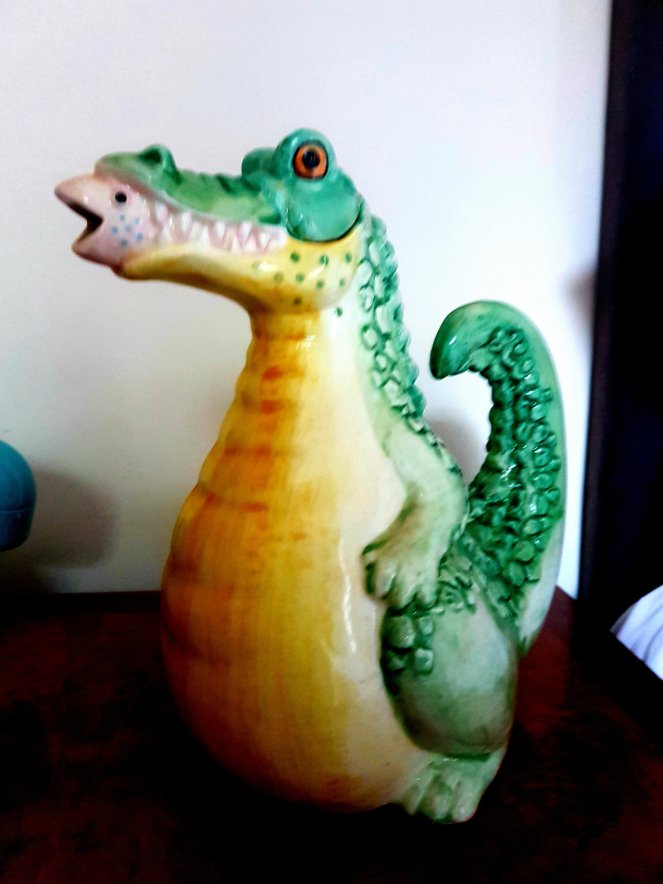
Train journey quick through countryside towards the South Coast. Hotel The Norfolk Arms was quaintly regal underneath the ramparts walls of Arundel Castle. An hour later I had fed ducks, purchased an eccentric tea pot in the shape of a crocodile (paint brush holder for inspiring children’s writer..everything to help the creative juices) , a electronic jazz CD (amazing what Cancer Research turns up) and an odd assortment of books on bringing up chickens and geese. Somewhat loaded like a pack horse I wended back through the rambling streets to sit awhile in the Cathedral to ponder on the meaning of life. An organ recytle at Heathrow decibels provided just ten minutes of pondering. I needed an hour but the ears said no way. Back to the hotel.

A huge bed and a hearty full English breakfast next morning set me up for the day ahead. At the barn the other enthusiasts arrived. There is always that odd half hour where you assimilate characters, clutch at conversationalist comments to decide if you will bond or not. Bit like Lost or The Beach, after some disaster and your all marrooned , a misplaced group of misfits with only one thing in common..in our case cheese.
But bond we did. At first the Australians from Kentish town were a little dismissive- bold Oz attitude brimming over and the older B&B lady little nervously lost of our conversation. But with some tea, quick changes of topic by me, or in my case saying politics was basically bollocks..we moved swiftly onto cheese.
Keeping clean and raw milk
Hands washed, aprons on and the odd assortment of practical cheesemaking equipment explained; the day was a revelation. We made brie, camembert , feta, yogurt, cream cheese, mascarpone and Lebnah. The alchemy of turning milk into cheese is a thrill but with a sense of calm necessary to patiently heat, stir, cut and jiggle curds you realize the day becomes more soporiphic and I am last feeling relaxed.

Living in France the making of brie or camembert might seem futile. The shops heave with it. But that’s the thing. Creating your own is a special bond you achieve with food. From grass to table I know how this cheese is made. Learning this skill will develop into other skills and before you can say Mesophilic flora danica…I am on my homestead journey.
Before I get into the detail..milk. Many countries worry unnecessarily about listerior caused by raw milk. It’s a somewhat out of date idea based on faulty research. Much of the issues come from poor equipment hygiene methods, relying on the fact that raw milk has been pasteurized (yes that is from Louis Pasteur of antiseptic fame) heated to kill bacterior. Little evidence is in place to support listerior reduction by pasteurization. Please read about this issue before deciding to use raw milk or not. In USA, Australia and New Zealand raw milk cheese is illegal unless the cheese matured. That puts paid to fresh cheeses. That’s a shame because heating kills the unique origin flavours of the milk.
But for our course pasteurized milk was used. Back in France I will use raw. It’s readily available at the supermarkets usually sold in a pouch like packaging.
So aprons on, hands scrubbed like a surgeon, we are ready to get into curds and whey. No spiders were present!
What do I need to make cheese
I think the most daunting part was equipment. Expensive or comlex? Not so. Basically you can use a lot of kitchen tools you already have, cleaniliness is paramount becuase you do not want any other bacteria that will affect the cheese bacteriors or be harmful to you or your cheese, and a relaxed mental attitude. Cheesemaking cannot be rushed. Having a bad day? It will likely translate into bad cheese.
So here goes.
Firstly there are 2 terms you will hear often – curds and whey. Curds are the solid part that will become cheese, whey is the liquid you remove.

You need a clean area to work in where you can leave the curds and whey after heating and have room for tools and somewhere near to hold the cheese moulds while they drain the whey from the curds. Note that you shouldnt put whey down the sink. Its full of protein and microbes and will cause bacterior in your pipework. Plus you can have some curd still intact and it can block your pipes too.
Whey is gold
It retains a third of milks calcium and protein, and aciditiy makes it highly digestible by chickens. A little like yogurt, its worth saving. Soaking grains in whey breaks down phytic acid to aid digestion, and therefore useful for breadmaking and baking. Sourdough can use whey as a jet propulsioned starter. It helps preserve mayonaise, and you can add to soups to raise protein levels, expecially good if your vegatarian.
So save your whey.
A large stainless steel pan to heat the milk, Use the stove or as I am going to do, get a dedicated induction ring. It heats quick and no residual heat which can make cheesemaking volatile re maintaining temperatures. A Bain Marie would work too. 90 degrees your ideal target temperature when deciding.
A stainless steel tank to hold max 20 litres. Plastic boxes are ok if you can keep bacterior free. Maybe use food grade plastic.

A thermo box or insulated box to hold the tank and keep the liquids ate temperature. I sent off for a Kango one of dense polystyrene, but I think I want something more robust for long term.
Measuring jug, measuring spoons, slotted spoons.
Thermometer – no guesswork please.
Acidity meter great if you can, for more accuracy and especially if making more complex cheeses.
A mini cake or cooling rack. This was a brilliant idea. Lots of people cut the curds with a knife. Not accurate and hard to cut the horizontals. The cake rack was a revalation producing identical sized cubes which make your cheese more homogonized and less risk of failure due to irregulars levels of whey removal. Are you still with me? Sorry but it will make sense .
Moulds – bacteria to ferment the curds to make cheese.
Controversial rennet
Starter – rennet. Some controversy here. Rennet, the enzyme Chymosin, traditional comes from the lining of a calves stomach that hasnt been weened, ie has only drunk its mothers colostrum milk.
That means you need to kill calves to get it. A byproduct of the beef and dairy industries are unwanted calves nd meat for veal. I wont eat veal, and one reason I want to make my own cheese, is to avoid calf rennet. It does make exceptionally good cheese, but I am just not happy about encouraging this byproduct. There are plant based rennets used alot now, especially as vegatarianism increases. It can be a little bitter, and does not work so well for aged cheeses, but for everyday fresh and soft cheeses, its fine. There are chemical rennets but they are affectively GMO – long term side affects unknown.
Plant rennets are: yarrow, nettles, ivy, fig leaves, thistles and mallow. Citric acid, lemon juice and vinegars are also used. Acids are your cheese friend.
Affinage
Cheese storage and aging to you and me. If you have a damp cellar or a wine cellar – lucky you. As yet I havent and no room to dig one out as yet. Therefore a wine fridge is the best solution as it keeps the ideal conditions for cheese aging – humidity and constant temperature. You will need cheese wax paper to wrap the cheeses or greaseproof works ok. No cling film.
Cheese moulds
Finally you need cheese moulds. These are round or square containers with holes in to let the whey drain out of the curds and let air circulate to aid drying.
You can make your own as long as they can be steralized. I bought mine and chose quite large ones about 10-15 cm diameters to produce big flat bries.
If you have a dishwasher your sterilizing not a problem. Otherwise you need to boil everything on the stove top. More steam and more messy.
Making cheese
At last, the best bit. When I decided to write about cheese making, I wasnt sure wheather to just go down the route of – oh that was a fun day, we made cheese, had a laugh, got messy; OR go the technical route and actually tell you how to make cheese. But that makes for a long post. So if you really dont want to know right now, just go straight to the photos and you will get an idea. If not, put your pinny on (apron slang), wash your hands (again) and lets get that milk into the pan to heat.
Milk
Full cream milk please, homogonize meaning well mixed. You need fat to make cheese. This is cows milk for brie, goats and sheep milk will need different methods and thats for another time.
Raw milk ideal if you can get this and you, like me, have no worries about listerior.
Before adding milk into pan, shake well for a minute. You need 4 litres for 3 cheeses of 240g. 300mls of cream added to milk to make brie. If you leave out the cream – you simply get camembert.

Heat the milk and cream to 32C. Transfer to the cheese vat and sprinkle over 1/4 teaspoon Mesophilic starter. Leave it to work for half a minute then stir thoroughly.
Add 1/16 teaspoon of white mould Penicilium Candidum and stir thoroughly.
The cheese vat should be left in the thermo container with the lid on. Leave for 90 minutes for the bacterior to work.
After 90 minute add 1.25 ml rennet to 12.5ml cold pre-boiled water. Trickle over the milk mixture and stir methodically to ensure the rennet distributed evenly. This causes the curds to split from the whey. Cover and leave for 45 minutes.
Cutting the curds
Next the fun part. Take the mini cake rack and draw across the now wobbly curd mixture. Keep the rack upright and draw towards you. Repeat trying not to overlap the previous cut area. Repeat accross the opposite direction to get cubes. Rest the curd for 10 minutes.


Now carefully and methodically lift curds onto slotted spoon and lightly jiggle to release the whey from the curds. Place back where taken out and repeat till all curds removed, jiggled and replaced. The whey will not resoke back, so lifting out releases whey. Rest curds for 10 minutes and repeat the jiggle process.
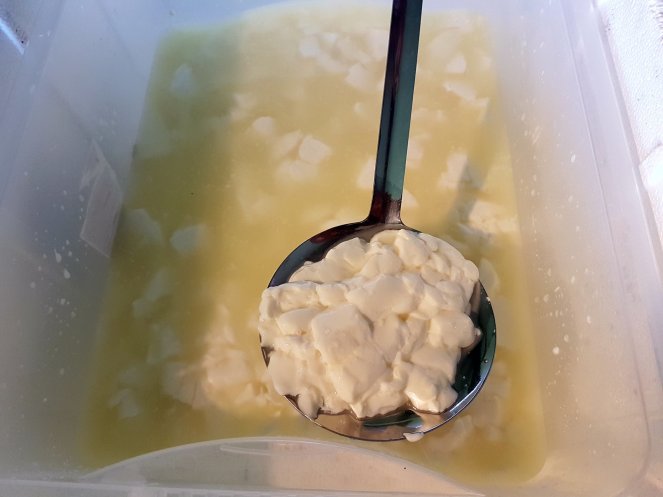
Another 10 minute rest an most of the curds will have sunk to base leaving whey above. Drain off 1 litre of whey only.
Final heat
Add 1 litre of hot water 60C to the curds slowly, to bring temperature to 35C only – no more. It should be 35C throughout the whole vat, so stir the hot water through gently and check with thermometer all over.

Leave for 10 minutes to finally heat the curds through. Now you have cheese.
Cheese moulds
Carefully remove the curds and place into the cheese moulds to drain. Top up where the curd sinks. Leave to drain and cover with cheesecloth or other linen. After 30 minutes, turn the curds over. Repeat turn again at 30 mnutes, then 1 hour, 3 hours and 5 hours. You can now see why cheese making should be carried out in the morning or you will pushing into the nightshift!

Leave to air-dry overnight – not in fridge.
Make a brine of 200g non iodised salt to 1.2 litres boiling water. Leave overnight.
The white stuff
Next day add 1/10th teaspoon of white mould to the brine and drop the cheeses in this soution. Leave for 30 minutes and turn cheeses, and leave for another 30 minutes.
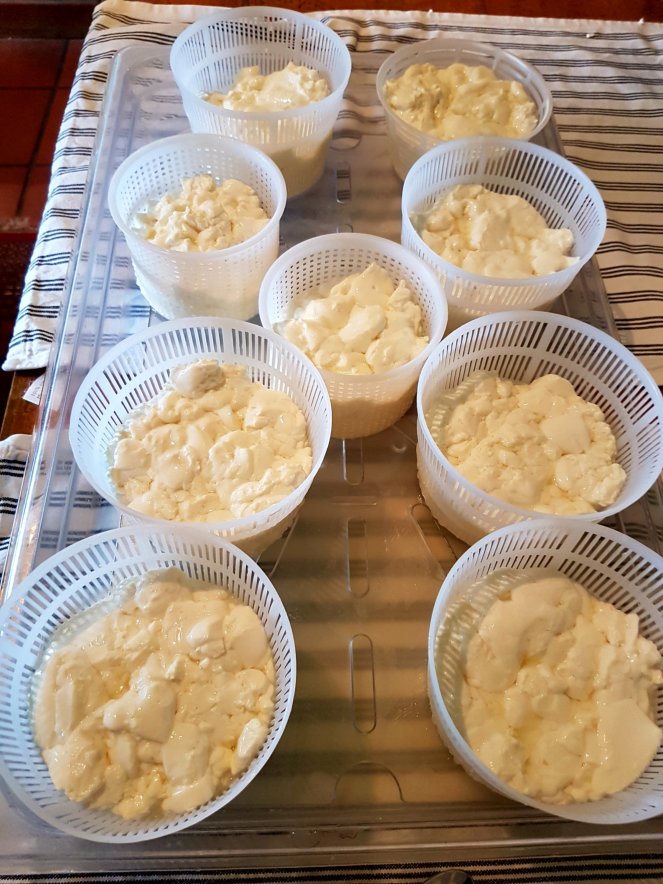
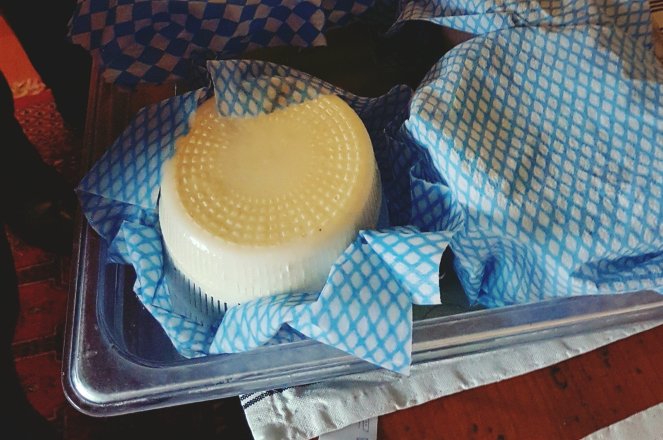

Remove cheese and place on racks to drain – air dry 245-48 hours, turning occasionally. Do not cover. Once cheese is damp but not wet, put in clean container without a lid for 7 days, turning the cheese daily.
Starting to look like a brie
After 4 days you should see that furry white mould. If not your cheese is too wet, so dry excess moisture with a paper towel. At day 7 or 8, remove and wrap cheeses in greaseproof paper, or ideally cheese wax paper, and then with cling film, pierced to allow air to circulate. Place in a cool pace or your wine fridge at 11-15 degrees.
Leave for 3-4 weeks. The cheese should then be ready. Re-wrap in wax paper of graseproof and store in fridge. Serve as you would normally. I like mine cold and firm from fridge, or you can leave out of fridge for a fuller flavour and creamy ooziness.
Phew – hard work? Yes its time consuming and I ended up with a huge respect for artisan cheesemaking. Therefore give yourself time and make a good quantity. It keeps well and will just get a fuller flavour the older it gets.
You can make other cheeses at the same time, feta, mascarpone, Labneh, ricotta and cream cheese. These are fresh cheeses and involve very little work and can slot in between the more involved brie making.
Good cheesemaking. I need a cup of tea.
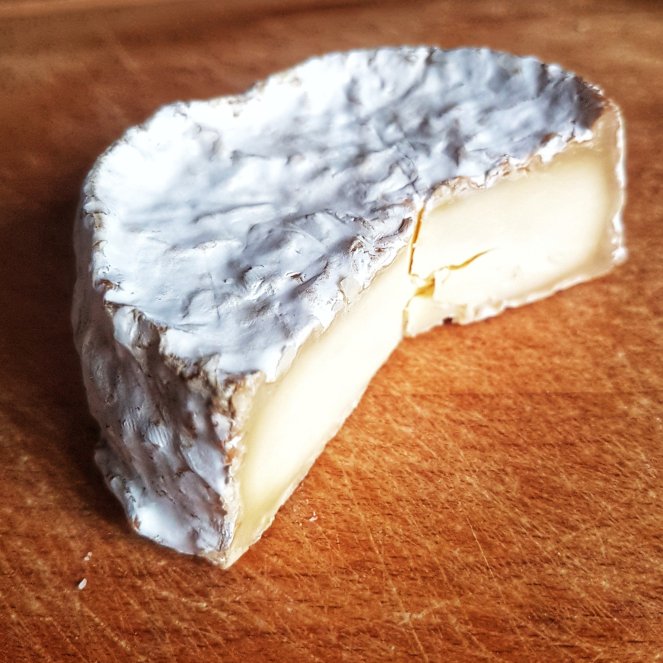
Mandy Norton can be contacted on 01903-889730 and her course is called The Cheesemaking Workshop. She has various cheesemaking courses and supplies notes and equipment to get you started.

I love making cheese. I haven’t done it by myself, you understand but have been privileged to help various skilled makers in the last 30 years, the most recent being my friend Christine who makes AOC Saint Nectaire in Cantal. I find it to be the most rewarding, relaxing and brain-calming activity. The merging of art and science rather as is wine making. Your article is exemplary and I so much enjoyed it. I also love the teapot …. he really is rather inspiring even for those of us that don’t aspire to writing for children. I am certain he will be a great ally as your books take shape. The cheese looked fabulous by the way and I am sure it tasted superbe!
LikeLiked by 1 person
I am a cheesemaking convert and have my eye on the barn next to mine to become our cave. It’s therapy that you get to eat. The brie tasted great and a package is heading my way with starter cultures for making more brie and feta for husband, who misses his homemade cheeses from Romania. Huge respect for cheesemakers. It’s more physical than you think. Oh yes crocodile..couldnt leave him behind. He needed a home.
LikeLiked by 1 person
It’s very physical and I think that is part of why I find it so therapeutic and mind-clearing. So glad you are thinking of carrying on making your own … nothing beats the fruits of your own labours and in France you should be able to sell some at your local markets if you want to. Hope Tony enjoys the cheese you make – I’d be very interested to understand what his local cheeses were. Not a clue about Romanian cheese which is rather parochial of me!
LikeLike
Good job. Now you are almost ready to make roux. Or, beer. 🍺🍺🧀🧀
LikeLiked by 1 person
Ah now that sounds like husband heaven. Mind you I now love beer. Goes well with cheese and my other favourite..Indian cuisine.
LikeLiked by 1 person
Well, beer is just liquid bread. heh.
LikeLiked by 1 person
Well put. Husband has kidney stones..ouch. Beer is the only solution it seems. 😉
LikeLike
🍺🍺🍺
LikeLiked by 1 person
🍻
LikeLike
Wow, ok I’m impressed. I had no idea that so much was involved in this and now I understand about vegan cheese and rennet (hope I’ve spelt it right). I love that you’ve written about this, it’s opened my eyes to a different world!
LikeLiked by 1 person
It is complex but easily broken into stages. The rennet can be difficult if veggie and be bitter. I want to experiment with natural ones later from the garden. Glad it was helpful.
LikeLiked by 1 person
Absolutely loved it … let me know how the veggie ones develop. X
LikeLiked by 1 person
Will do. Husband is actually making feta today. He likes to experiment so hopefully he doesn’t create any cheese monsters!
LikeLike
Fantastic … and lovely that you have something together that you enjoy ❤️❤️
LikeLiked by 1 person
We are joined at the hip on most things. We even look alike!!!
LikeLiked by 1 person
Awww that’s so lovely! ❤️❤️
LikeLiked by 1 person
WOW – now this is amazing. I enjoyed reading this – it does seem like a lot of work. But well worth it – I’m sure.
LikeLiked by 1 person
Thank you. Yes at first it does seem involved but actually once your in the swing of it, quite easy.
LikeLiked by 1 person